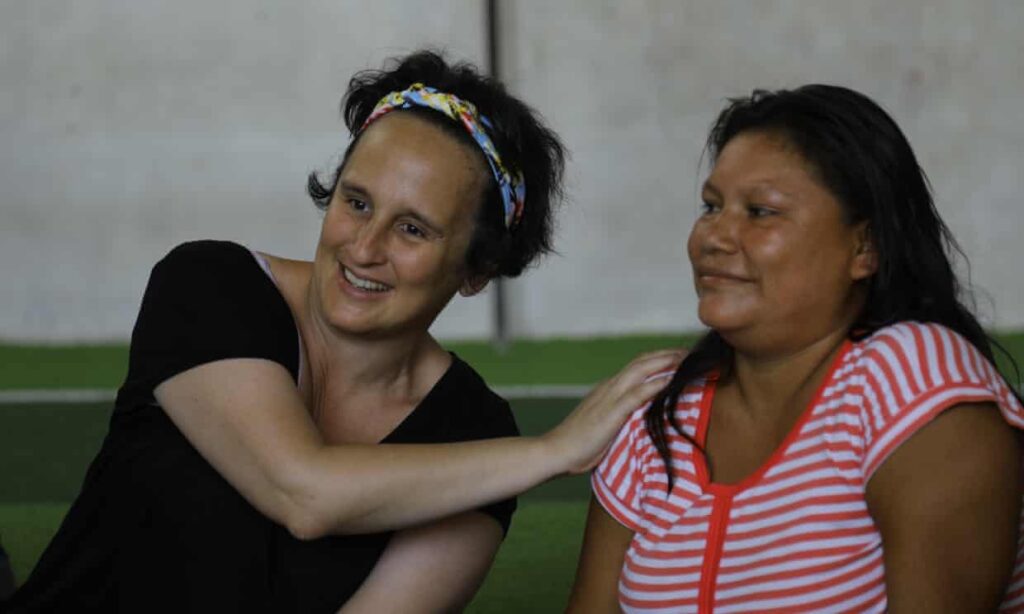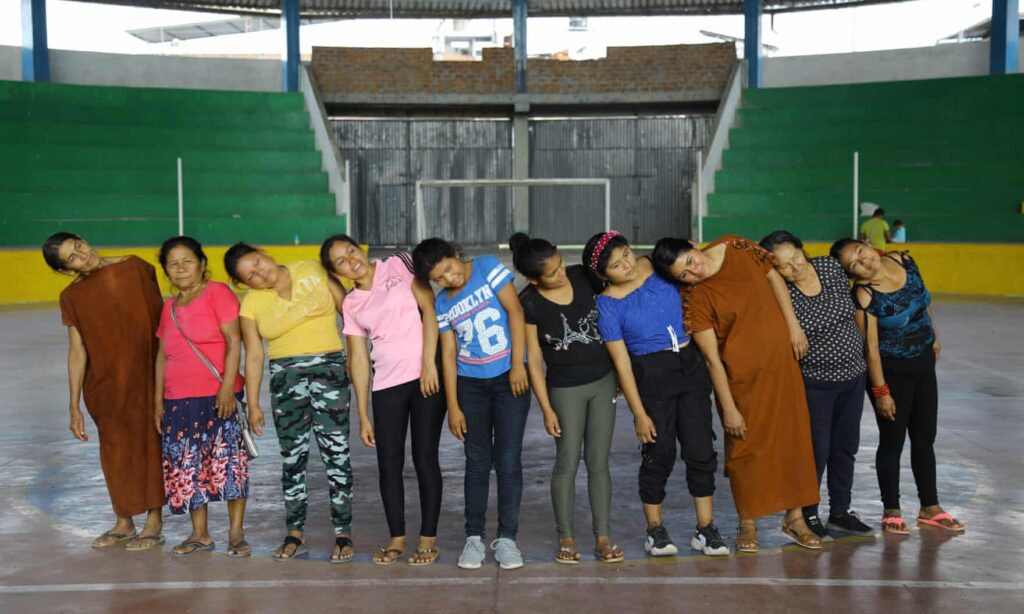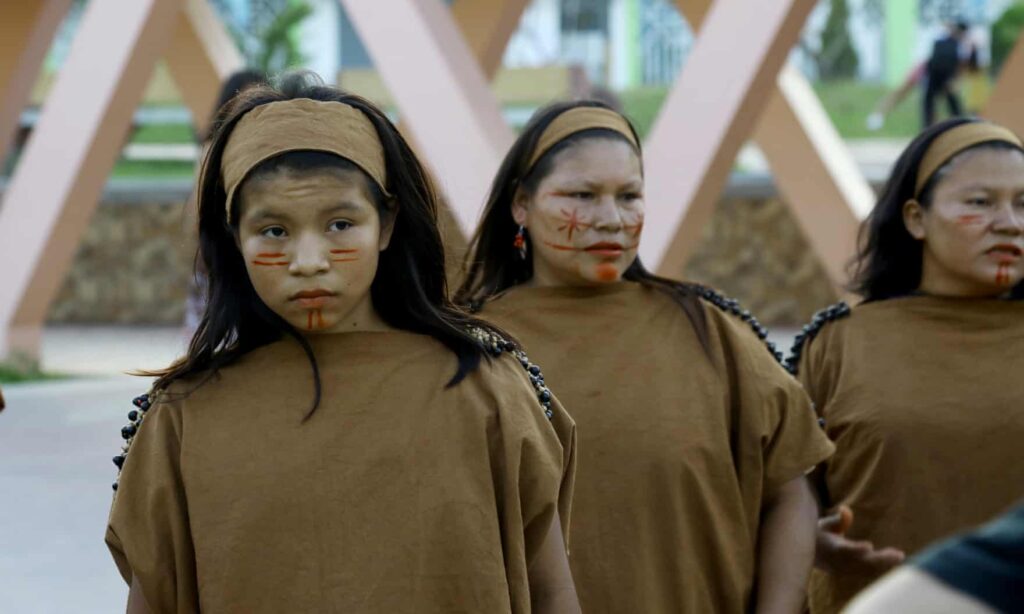- Nearly 70 000 people were killed in Peru in an insurgency started by communist guerrilla group, Shining Path which fought the Peruvian government during the 1980s and 90s.
- The Buenas Noticias (Good News) programme has been helping women who survived the violence to recover since 2019.
- Buenas Noticias also helps the children of survivors to understand what their mothers and grandmothers experienced so that they can help to support them.
With a hand on the shoulder of the woman in front of her, Yolanda Rivera Charete begins to sway gently. She sings “Tsame tsinane, ashintsitanakebe” (Come on women, let’s go forward with strength) in Asháninka, the language of her tribe.
Dressed in a kushma, a long clay-brown tunic, face patterned red from achiote seeds — the source of annatto colouring — Rivera Charete, 63, and 15 others, dance to remember and to show their missing loved ones what has been happening in their lives.
In this dance workshop for members of the Asháninka, Peru’s largest indigenous Amazon group, the moves celebrate resistance while lamenting those enslaved, murdered and “disappeared” by the communist guerrilla group Shining Path, which fought the Peruvian government during the 1980s and 90s.

“I feel now that I am forgetting what happened to me. I feel calm, there is not too much worry,” says Rivera Charete from a gym under a corrugated metal roof in the jungle town of Mazamari, 150 miles northeast of the capital, Lima.
Charete fled her community, Centro Tsovameni, with eight children in 1989 when Shining Path fighters tortured and murdered her cousin, Isaias Charete, the village leader. “We’ve all been damaged psychologically,” she says.
The Buenas Noticias (Good News) programme
Mónica Silva, associate professor in performing arts at Peru’s Pontifical Catholic University in Lima, has been a choreographer on the Buenas Noticias (Good News) programme since October. She says the initiative, started by the International Committee of the Red Cross (ICRC), helps women connect with others who suffered during the insurgency and allows younger women to understand and support mothers and grandmothers.
“To touch and hold somebody, it’s not just about affection, it’s saying we are together,” says Silva.

“The young never lived the violence. This moment is the chance for the mum to talk about it. It’s not just about the dance, it’s about what happens in between the dancing.”
Eva Esteban, a psychologist with the ICRC, says: “Despite the disappearances, lives have gone on. What they want to do with this dance is to tell their loved ones the good news that has happened to them during the course of their life since they disappeared.
Nearly 70 000 people were killed in Peru between 1980 and 2000. Shining Path — Sendero Luminoso — was responsible for more than half of the deaths, according to Peru’s truth and reconciliation commission. Many Amazonians trapped between the insurgents and the Peruvian forces were forcibly recruited by the rebels and between 8 000 and 10 000 were violently displaced. About 50 communities disappeared and mass graves were discovered subsequently.
Before Rivera Charete began dancing, she says she felt “hard, because I was filled with the things that have happened”. But she adds: “Now, with this movement that they are teaching us, I feel looser.”
Her daughter Hilda, says: “I didn’t live through what my mother and older siblings did. But thanks to this dance, I can see her relief. She has let go of the past.”
‘Joy in the middle of pain’
Peals of laughter echo around the gym, as the women share a joke and rub each others’ backs. After three weeks of rehearsal, they are to perform publicly in an amphitheatre in the town square.
The dances are full of movements such as slashing with a machete, casting a fishing line and weaving. “They are very in touch with movement, with nature, with the earth, with laughter,” says Silva. “They are not ashamed to have joy in the middle of the pain.”

Luzmila Chiricente, 68, is the oldest here. She was the leader of Cushiviani, an Asháninka community invaded by Shining Path in 1988. The rebels killed men, forcibly recruited boys and sexually abused girls. They kidnapped one of her five children, Juan, then 14. She never saw him again. Her eldest son, now 52, escaped by hiding in the rainforest.
“Sendero thought that by taking away my son they were going to shut me up, but I denounced them nationally and internationally,” she says. The grief remains, though.
“We can’t forget. There are some of us who have suffered a lot,” says Chiricente. When she is reminded of what happened, the past replays in her mind “like a movie”.

Chiricente is the founder of Peru’s first indigenous women’s organisation, Fremank (the Regional Federation of Indigenous Asháninka, Nomatsiguenga and Kakinte Women of the Central Jungle), and says it is vital that women support each other.
“For the girls who don’t know what trauma is, the terror that happened to us, they will understand [now] so that it doesn’t happen again,” she says.
The Buenas Noticias programme began in 2019 among bereaved women in Ayacucho, the region that bore the brunt of the violence and where hundreds live without knowing what happened to their loved ones. It was adapted for the native Amazonians this year with the help of Lima theatre company La Plaza.
“Good things are also in their life — it is not all suffering,” says Esteban.
This article was originally published by The Guardian’s global development project — part of Guardian News & Media Ltd.
Dan Collyns is a British multimedia journalist based in Peru.

